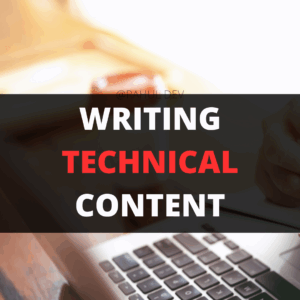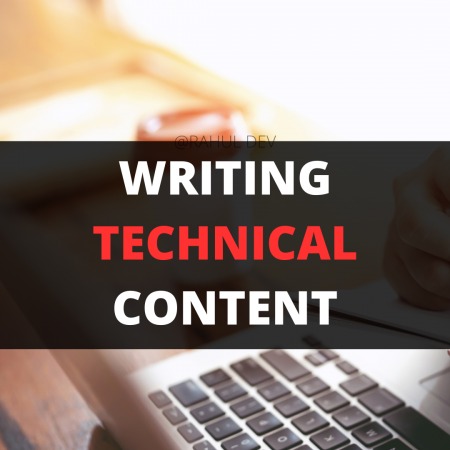Writing Technical Content
Insights by Dr. Rahul Dev

Understand Practical Aspects
Understand the role of technical research

Insights by Dr. Rahul Dev

Understand the role of technical research

Protect your innovations across multiple countries and create strong patent portfolio to boost business valuation
Local and global brand protection through international trademark registrations
Extensive research and business writing for technical whitepapers and B2B content products
Here I discuss a case study for writing technical content using proven methods for technical content development and FAQ optimization. The case study documents an experience implementing a comprehensive content strategy for a pioneering AI data tech platform. The goal aimed to transform complex AI and data concepts into accessible content through heavily researched educational blog posts and user-friendly FAQ sections. The project significantly improved user understanding, increased engagement, and supported user adoption across technical and non-technical audiences. As a PhD in Data Science, my research and analytical skills come in really handy to execute the technical content writing projects.
This article covers following topics:
Strategy for Writing Technical Content for AI Data Platform
Audience Research for Writing Technical Content
Content Planning Framework for Writing Technical Content
Data Collection Methods for Writing Technical Content
Content Development Framework for Writing Technical Content


While working as the content lead for an AI company specializing in data tech, two primary objectives shaped the work. The first objective required creating educational blog posts explaining complex AI and synthetic data concepts in accessible language. The second objective involved developing comprehensive FAQ content addressing the needs of both technical and non-technical users. The challenge presented significant difficulties. The data technology involves sophisticated machine learning concepts that needed clear communication to audiences with varying levels of technical expertise. These audiences ranged from developers and data scientists to business decision-makers with limited technical knowledge.
The process began with extensive research to understand audience segments. Technical analysis identified three key personas through user interviews and analytics data. Technical implementers, including developers and data scientists, represented 35% of the audience. Business decision-makers comprised 40% of the audience. Non-technical end users made up the remaining 25% of the audience. A content needs assessment created detailed profiles of each segment’s knowledge levels and requirements. Developers possessed high technical expertise and showed primary interest in implementation details and code examples. Data scientists brought high domain expertise and focused on algorithms, data quality, and statistical validity. Business users had lower technical expertise and sought understanding of business value, use cases, and compliance matters.
The research from Nielsen Norman Group shows well-structured technical content has 55% higher engagement. This data informed the development of a comprehensive content calendar covering five key synthetic data themes. The themes included foundational concepts explaining synthetic data and generation methods. Technical implementation covered anonymization techniques and model training approaches. Business applications explored use cases across industries. Compliance and regulations addressed privacy standards and GDPR considerations. Future innovations examined emerging techniques and trends in the field.
A systematic workflow based on technical writing frameworks established the content development process. The research phase consumed 25% of the time and involved interviews with internal subject matter experts. This phase also required analysis of over 15 academic papers on relevant algorithms and reviews of competitor messaging and documentation.
The outlining phase took 15% of the time and created structured outlines with defined key takeaways. The process identified technical concepts requiring simplification and planned visual elements and examples to enhance understanding.
The writing phase comprised 30% of the development time. This phase developed core content using plain language principles and created analogies and real-world examples for complex concepts. The process of writing technical content incorporated relevant case studies and use cases to demonstrate practical applications.
The editing phase utilized 20% of the time and simplified technical terminology throughout the content. This phase added definitions for unavoidable technical terms and verified logical flow between concepts to ensure readability. The review phase took the final 10% of the time. Technical review by the engineering team ensured accuracy, while non-technical review checked for readability. Final adjustments based on comprehensive feedback refined the content before publication.
The multiple sources identified the most relevant questions for the FAQ section. The analysis of over 300 support tickets revealed common questions from existing users. Reviews of more than 50 sales call transcripts provided insight into prospect concerns. User testing sessions with 20 participants gathered direct feedback on confusing concepts. Direct user surveys collected responses from 127 users about their information needs. Analysis of search queries on existing documentation identified content gaps. Monitoring of community forum discussions revealed emerging questions and trends, which completed the process of data collection methods for writing technical content.
Also, research from Nielsen Norman Group informed the design of an FAQ structure with three key characteristics. The content received segmentation by user type, with separate sections for developers, data scientists, business users, and general audiences. The organization featured topic clusters covering getting started guidance, platform capabilities, SDK implementation, data quality and validation, security and compliance, troubleshooting, and billing and support. The implementation made content searchable and filterable with full-text search functionality, category filters, difficulty level indicators, and estimated reading time for each answer, which provided a strong framework for writing technical content.
In use, each FAQ followed a research-backed format for maximum clarity and usefulness. The format began with a direct answer in one to two sentences, providing immediate value. An expanded explanation of two to three paragraphs followed to provide necessary context. Examples or illustrations appeared where applicable to enhance understanding. Links to related documentation offered pathways to deeper knowledge. Next logical questions guided users through related content for continued learning. These steps ensured the development of an effective content development framework for writing technical content.
Subsequently, the implementation of technical content writing plan began with publication of an initial set of five cornerstone articles establishing core concepts. A consistent visual style for diagrams and illustrations enhanced recognition and comprehension. The creation of a library of reusable explanations for common concepts ensured consistency across content. The establishment of a technical review process with the engineering team maintained accuracy throughout the content library. The FAQ launched with 75 carefully crafted answers addressing the most common user questions. Progressive disclosure design implemented basic answers with expandable details to accommodate different information needs. Visual enhancements included icons, syntax highlighting, and comparison tables to improve comprehension. Feedback mechanisms on each answer allowed continuous improvement based on user responses.
The blog engagement metrics showed 72% higher time-on-page compared to previous technical content, indicating stronger user interest. Understanding metrics through post-read comprehension surveys demonstrated 86% understanding rate among non-technical users, up from 47% previously. Search performance improved significantly, with reduced “no results found” searches by 63%. Support impact metrics revealed decreased basic technical support tickets by 42% within three months of implementation. Lead generation data showed blog content directly contributed to 23% of new qualified leads.
The user feedback reinforced the success of the content strategy. A business user commented, “Finally, explanations that make sense without a PhD in computer science.” A developer noted, “The code examples alongside conceptual explanations are exactly what I needed.” A data scientist shared, “The FAQ section saved me hours of troubleshooting.” A business analyst remarked, “This is the first synthetic data explanation that actually helped me understand the technology.”
The project yielded important insights about bridging technical and business language. A consistent terminology framework proved essential for communication across knowledge levels. Visual elements effectively explained complex concepts where text alone might prove insufficient. The provision of both conceptual and practical explanations met diverse learning needs among users.
Layering information appropriately emerged as a crucial strategy. The approach started with clear, simple explanations accessible to all users. Technical depth added progressively allowed users to deepen their understanding as needed. Allowing users to choose their level of detail improved satisfaction across knowledge levels.
Validation with diverse audiences ensured comprehensive effectiveness. Testing content with both technical and non-technical users revealed different comprehension challenges. Systematic incorporation of feedback led to continuous improvement. Measurement focused on understanding rather than mere engagement provided more meaningful metrics.
Maintaining living documentation proved vital for long-term success. Regular review cycles kept content accurate and relevant as technology evolved. Updates tracked product evolution to maintain alignment between documentation and features. Tracking and responding to user feedback created a virtuous cycle of continuous improvement.
The project demonstrated that even highly complex technical concepts can achieve accessibility through thoughtful content strategy and execution. Understanding diverse audience needs and implementing research-backed approaches to technical communication successfully transformed how users engaged with the synthetic data platform.
The systematic approach to blog content and FAQ development resulted in measurable improvements across multiple metrics. User understanding, product adoption, and customer satisfaction all increased while support burden decreased by 42%. This case study serves as a model for effective technical content development that bridges the gap between complex technology and diverse user needs.

As a business coach and thought leader, I cannot emphasize enough the importance of innovation, new software patents, mobile apps, and patents for tech companies, startups, and entrepreneurs. The world is rapidly evolving, and staying ahead of the curve is vital for success. Embracing technological advancements such as blockchain and AI can unlock unprecedented opportunities, streamline operations, and propel businesses into the future with competitive valuation via intangible assets.
Click Here for AI Startup Valuation Guide.
For instance, blockchain technology can revolutionize supply chain management and secure data sharing wherein innovative business models are explained to the audience via technical whitepapers, while AI can automate and optimize decision-making processes. Mobile apps are no longer just a luxury; they have become essential tools for engaging customers and offering personalized experiences. Furthermore, securing digital innovation patents is crucial for protecting intellectual property, fostering innovation, and maintaining a competitive edge. By investing in these areas, businesses can position themselves as industry pioneers and pave the way for a prosperous future after thoroughly conducting the due diligence and reviewing the legal opinion letters, which in case of digital assets can assist in determining the tokens as utility assets or coins as utility tokens before listing the assets at an exchange.
Our team of advanced patent attorneys assists clients with patent searches, drafting patent applications, and patent (intellectual property) agreements, including licensing and non-disclosure agreements. Advocate Rahul Dev is a Patent Attorney & International Business Lawyer practicing Technology, Intellectual Property & Corporate Laws. He is reachable at rd (at) patentbusinesslawyer (dot) com & @rdpatentlawyer on Twitter.
Quoted in and contributed to 50+ national & international publications (Bloomberg, FirstPost, SwissInfo, Outlook Money, Yahoo News, Times of India, Economic Times, Business Standard, Quartz, Global Legal Post, International Bar Association, LawAsia, BioSpectrum Asia, Digital News Asia, e27, Leaders Speak, Entrepreneur India, VCCircle, AutoTech).
Regularly invited to speak at international & national platforms (conferences, TV channels, seminars, corporate trainings, government workshops) on technology, patents, business strategy, legal developments, leadership & management.
Working closely with patent attorneys along with international law firms with significant experience with lawyers in Asia Pacific providing services to clients in US and Europe. Flagship services include international patent and trademark filings, patent services in India and global patent consulting services.
Global Blockchain Lawyers (www.GlobalBlockchainLawyers.com) is a digital platform to discuss legal issues, latest technology and legal developments, and applicable laws in the dynamic field of Digital Currency, Blockchain, Bitcoin, Cryptocurrency and raising capital through the sale of tokens or coins (ICO or Initial Coin Offerings).
Blockchain ecosystem in India is evolving at a rapid pace and a proactive legal approach is required by blockchain lawyers in India to understand the complex nature of applicable laws and regulations.